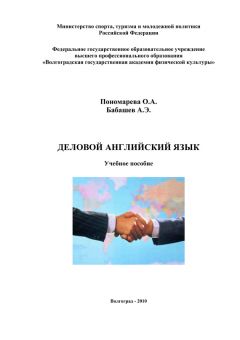Текст книги "Деловой английский язык"

Автор книги: А. Бабашев
Жанр: О бизнесе популярно, Бизнес-Книги
сообщить о неприемлемом содержимом
Текущая страница: 3 (всего у книги 6 страниц)
UNIT 5
BUSINESS WRITING
Steps to Good Writing
How do you write, with pen or pencil or on a personal computer? The tools vary, but the process is the same: Plan, Outline, Draft, Edit, Rewrite, and Proofread.
Plan first. Planning to write requires thinking about your audience and purpose, gathering necessary information, and reviewing appropriate resources. Plan your time and your place to write. Try to create an environment in which you can focus. Research facts, figures, and missing details first so that your draft can flow without interruption.
The writing process doesn't always follow neatly progressive steps, but it must begin with a plan. Then, you have choices. Some people outline first; some write the draft. You may start with either, but must include both steps.
The content should be accurate, clear, and correct: grammar, punctuation and spelling. It is important that each section contains only information pertinent to it. It is necessary that each paragraph: (1) focuses on one topic; (2) is limited to five or six sentences; (3) has most sentences in active voice; (4) each sentence contains an average of 15 to 20 words. Ideas must flow logically. There should be the following reference material on your shelf: a good English/ Russian dictionary and a good Russian/ English dictionary; on line: a spell checker and a grammar checker. Always remember the words of Samuel Johnson: «What is written without effort is in general read without pleasure».
How to Write Business Letters
On the job secretaries most often write short letters or fax-messages. Businesspersons have always used powerful communication to achieve wealth and position. The right message at the right time and place is a success. The principles of good correspondence are 1) writing often and 2) responding quickly. The keys to letter writing art still exist. If you wish to follow them, you will see the improvement in your very next letter.
1. Begin from the end. Decide what you would like to happen as a result of your letter. Want money? To sell something? A promotion? Summarize your letter in a sentence. The best letters have a strong sense of purpose.
2. Put yourself in your reader's place. Therefore be friendly and nice. Never write in anger. Your anger will evaporate: your letter will remain. Find ways to turn negative statements into positive ones.
3. Write plainly. Keep your sentences short – one idea in each. Any sentence longer than two typed lines is automatically suspect. Try to write the way you talk.
4. Decide what information is important and what is irrelevant. Chop out the whole paragraphs if they do not contribute. In particular, pay attention on adjectives as Voltaire wrote «The adjective is the enemy of the noun».
5 Use active verbs. Be brave not to write «Your invoice has been misdirected» instead of «I have misdirected your invoice». Whenever you can, use pronouns I, we, and you addressing your reader by name «Dear Ms White». The passive voice sounds rather wimpy.
6. Check your grammar, spelling, punctuation, and style. Set up a clean, logical format for your letter. Read the text aloud to yourself, or, better, to someone else and ask him or her to look critically at your draft.
7. End the letter with an action step. The last sentence of your letter should suggest the reader's or your own next move like «If you have any problems, please do not hesitate to call us at…».
VOCABULARY

√ Как написать почтовый адрес
Когда вы пишете свой домашний адрес, уясните самое главное – письмо в ваш почтовый ящик будет доставлять РУССКИЙ почтальон, который, возможно, не знает, что street – это улица. Главное, чтобы, ваш почтовый адрес правильно и без ошибок был воспринят РУССКИМ ЧЕЛОВЕКОМ.
Если вы пишете: 35, Workers street, 18, то будьте готовы к тому, что ни одно письмо не дойдёт по вашему адресу: улица Рабочих, дом 35. кв.18.
Раз в России принято написание УЛИЦА-ДОМ-КОРПУС-КВАРТИРА, то и писать надо именно так:

Таблица соответствия русских букв латинским, написание сложных имён и фамилий

Примеры написания сложных имён и некоторых окончаний фамилий:

Сложные для написания названия городов, принятые в англоязычных странах



При написании адреса на английском языке вы можете взять за основу британский или американский вариант, в зависимости от ваших предпочтений. Но существует одно общее правило: если по-русски мы идем от большого к малому (страна, город, улица и т.д.), то по-английски все наоборот: номер или название офиса, при необходимости этаж (Floor 2 (ам.) 2nd floor (брит.)), номер дома (house), улица (street), город (city), область (region), индекс (ZIP-code), страна (country).
Обратите внимание: "офис": американцы сказали бы "office", если в вашем распоряжении всего лишь скромная комната, и "suite", если вы хозяин офиса, состоящего из нескольких комнат. Жители Великобритании используют слово "office" в обоих случаях.
Английские эквиваленты русских наименований пишутся следующим образом:

Основные выражения
Существуют стандартные выражения, часто употребляемые в деловой переписке на английском языке, использование которых придаст вежливый и официальный тон вашему посланию.
1. Обращение

2. Вступление, предыдущее общение.

3. Указание причин написания письма

4. Просьба

5. Соглашение с условиями.

6. Сообщение плохих новостей

7. Приложение к письму дополнительных материалов

8. Высказывание благодарности за проявленный интерес.

9. Переход к другой теме.

10. Дополнительные вопросы.

11. Передача информации

12. Предложение своей помощи

13. Напоминание о намеченной встрече или ожидание ответа

14. Подпись

STRUCTURE OF A BUSINESS LETTER
Sender's address
In correspondence that does not have a printed letterhead; the sender's address is written on the top right-hand side of the page.
In the UK, in contrast to the practice in some countries, it is not usual to write the sender's name before the sender's address.
Date
The date is written below the sender's address, sometimes separated from it by a space. In the cases of correspondence with the printed letterhead, it is also usually written on the righthand side of the page.
The month in the date should not be written in figures as they can be confusing; for example, 11.01.1998 means 11th January 1998 in the UK, but 1st November 1998 in the US. Nor should you abbreviate the month, e.g. Nov. for November, as it simply looks untidy. It takes a moment to write a date in full, but it can take a lot longer to find a misfiled letter, which was put in the wrong file because the date was confusing.
Many firms leave out the abbreviation 'th' after the date, e.g. 24 October instead of 24th October. Other firms transpose the date and the month, e.g. October 24 instead of 24 October. These are matters of preference, but whichever you choose you should be consistent throughout your correspondence.
Inside's (or receiver's) address
This is written below the sender's address and on the opposite side of the page, i.e. the left-hand one.
1. Surname known
If you know the surname of the person you are writing to, you write this on the first line of the address, preceded by a courtesy title and either the person's initial(s) or his/her fist given name, e.g. Mr. J.E. Smith or Mr. John Smith, not Mr. Smith. Courtesy titles used in addresses are as follows:
• Mr. (with or without a full stop; the abbreviated form 'mister' should not be used) is the usual courtesy title for a man.
• Mrs. (with or without a full stop; no abbreviated form) is used for a married woman.
• Miss (not an abbreviation) is used for an unmarried woman.
• Ms (with or without a full stop; no abbreviated form) is used for both married and unmarried women. Many women now prefer to be addressed by this title, and it is a useful form of address when you are not sure whether the woman you are writing to is married or not.
• Messrs (with or without a full stop; abbreviation for Messieurs, which is never used) is used occasionally for two or more men, e.g. Messrs P. Jones and B.L. Parker) but more commonly forms part of the name of a firm, e.g. Messrs Collier & Clerk & Co.
• There are many special titles, which should be included in addresses. They include:
· academic or medical titles, e.g. Doctor (Dr.), Professor (Prof.)
· military titles, e.g. Captain (Capt.), Major (Maj.), Colonel (col.)
· aristocratic title, e.g. Sir (which means that he is a Knight; not be confused with the salutation 'Dear Sir' and always followed by a given name – Sir John Brown, not Sir J. Brown or Sir Brown), Dame, Lord, Baroness, etc.
• Esq (with or without a full stop; abbreviation for Esquire) is seldom used now. If used, it can only be instead of 'Mr' and is placed after the name, e.g. Bruce Hill Esq., not Mr. Bruce Esq.
2. Title known
If you do not know the name of the person you are writing to, you may know or be able to assume his/her title or position in the company, e.g. the Sales Manager, or the Finance Director, in which case you can use it in the address.
3. Department known
Alternatively you can address your letter to a particular department of the company, e.g. The Sales Department, or The Accounts Department.
4. Company only
Finally, if you know nothing about the company and do not want to make any assumptions about the person or the department your letter should go to, you can simply address it to the company itself, e.g. Soundsonic Ltd., Messrs Collier & Clerke & Co.
Order of inside addresses
After the name of the person and/or company receiving the letter, the order and style of addresses in the UK and in the US, is as follows:


Style and punctuation of addresses
Both the addresses may be 'blocked' (i.e. each line is vertically aligned with the one above) or 'indented', as below:

There are no rules stating that one style or the other must be used, though blocking, at least in addresses, is more common. In any case you must be consistent, i.e. do not block the sender's address and then indent the inside address.
If punctuation is used, each line of the address is followed by a comma, except the last line. But, the majority of firms now use open punctuation, i.e. without any commas.
'For the attention of'
An alternative to including the recipient's name or position in the address is to use an 'attention of'.
e. g. For the attention of Mr. R. Singh (British English) or
Attention: Mr. E.G. Glass, Jr. (American English)
Salutations
• Dear Sir opens a letter written to a man whose name you do not know.
• Dear Sirs is used to address a company. Note: in the US – Gentlemen.
• Dear Madam is used to address a woman, whether single or married, whose name you do not know.
• Dear Sir or Madam is used to address a person you know neither the name nor the sex.
• When you do not know the name of the person you are writing to, the salutation takes the form of Dear followed by the person's surname. Initials or first names are not generally used in salutations: Dear Mr. Smith, not Dear Mr. J. Smith. The comma after the salutation is optional.
The body of the letter
This may be indented or blocked. It is as matter of choice. Whichever style you use, you must be consistent and use that style all through the letter.
It is usual to leave a line space between paragraphs in the body of the letter; if the blocked style is used, this is essential.
For the information concerning the linguistic aspect of writing the body of the letter, consult the following chapters of my diploma paper.
Complimentary closes
• If the letter begins with Dear Sir, Dear Sirs, Dear Madam, Dear Sir or Madam, it will close with Yours faithfully.
• If the letter begins with a personal name – Dear Mr. James, Dear Mr. Robinson – it will close with Yours sincerely.
• Avoid closing with old-fashioned phrases such as We remain your faithfully, or Respectfully yours, etc.
• Note that Americans tend to close even formal letters with Yours truly or Truly yours, which is unusual in the UK in commercial correspondence. But a letter to a friend or acquaintance may end with Yours truly or the casual Best wishes.
The comma after the complimentary close is optional. The position of the complimentary close – on the right, left or in the center of the page – is the matter of choice. It depends on the style of the letter (blocked letters tend to put the close on the left, indented letters tend to put them in the centre) and on the firm's preference.
Signature
Always type your name after your handwritten signature and your position in the firm after you typed signature. This is known as 'the signature block'. Even though you may think your signature is easy to read, letters such as 'a', 'e', 'o', and 'v' can easily be confused.
It is, to some extend, a matter of choice whether you sign with your initial(s), e.g. D. Jenkins, or your given name, e.g. David Jenkins, and whether you include a courtesy title, e.g. Mr., Mrs., Miss, Ms. In your signature block. But if you give neither your given name nor your title, your correspondent will not be able to identify your sex and may give you the wrong title when he/she replies. It is safer therefore, to sign to sign with your given name, and safest of all to include your title.
Including titles in signatures is, in fact, more common among women then among men, partly because many women like to make it clear either that they are married (Mrs.) or unmarried (Miss) or that their martial status is not relevant (Ms.), and partly because there is a tendency to believe that important positions in a company can only be held by men. It would do no harm for men to start including their titles in their signatures.
Per pro
The term 'per pro' (p.p.) is sometimes used in signatures and means 'for and on behalf of'.
Secretaries sometimes use p. p. when signing a letter on behalf of their bosses.
When writing on behalf of your company, it is useful to indicate your position in the firm in the signature.
Enclosures
If there are many enclosures, e.g. leaflets, prospectus, etc., with the letter, these may be mentioned in the body of the letter. But many firms in any case write Enc. or Encl. At the bottom of the letter, and if there are a number of documents, these are listed, e.g.


Formatting Envelopes for Business Letters
It is best to type an envelope for a business letter. Most word document programs contain an envelope labeling function to help you. All you need to do is indicate the size of envelope you are using and type the correct information in the appropriate fields, for example:

TYPES OF BUSINESS LETTERS
Письмо-запрос информации (Inquiry Letter)
An inquiry (also spelt enquiry) is sent when a businessman wants some information, especially about:

A businessman will save unnecessary correspondence by giving full details that are relevant.
If a prospective customer approaches suppliers for the first time, it is useful to tell them something about his own business, the kind of goods he needs and for what purpose they are required. In this case of customers of long standing or repeat orders, the inquiry may be very simple. Often a phone call or a postcard will do.
The structure of an Inquiry letter

Пример письма-запроса информации

Письмо-ответ на запрос информации (Quotations/Offers)
The quotation in reply to an inquiry may be a simple one, containing simply the prices and other information asked for. The sales-conscious businessman, however, will take the opportunity to stimulate his correspondent's interest in his goods or services by including a sales message and the assurance that the customer will receive personal attention.
Offers are also sent without a preceding inquiry when a supplier wants to draw the attention of customers and new customers to a special product or range of goods. A firm offer is subject to certain conditions, a deadline for the receipt of orders, or a special price for certain quantities.
The structure of an Quotations/Offers

Пример ответа на запрос информации

Письмо-жалоба (Complaint Letter)
Mistakes may occur in day-to-day business, and these give cause for complaints. There might have been a misunderstanding about the goods to be supplied; perhaps the warehouse clerk made an error in addressing the parcel; sometimes a consignment is dispatched too late or delays are caused in transit; damages may have occurred during delivery; a manufacturing defect is discovered when a machine is used. The customer is understandably annoyed.
He will get better results if he takes the trouble to explain his complaint clearly, and to propose ways in which matters can be put right. His company may make mistakes too: firms often have to manage with insufficiently trained personnel or to contend with staff shortage, so mistakes and accidents happen.
The structure of a Complaint Letter



Пример письма-жалобы


Письмо-принесение извинений (Apology Letter)
It is particularly necessary to exercise tact in handling complaints. A disappointed customer cannot be put off with mere apologies – he is entitled to know how the mistakes will be remedied: when he will receive the goods ordered; what he is to do with the wrong consignment or the damaged goods he received; when he will receive a replacement for his defective machine, or if it can be repaired quickly.
The structure of an Apology Letter

Пример письма-извинения

Письмо-заказ (Order)
In comparison to the correspondence so far, placing an order is simple from the point of view of letter-writing. Very often the purchasing department or the buyer fills in an order form, although he may prefer to write a letter to make certain points quite clear. There could be special import regulations, which make it necessary to complete formalities, or he may want to stress delivery instructions or other matters.
The supplier sends an order acknowledgement promptly, to thank his customer for the order. If prices or delivery times have changed, the customer must be notified. If the goods ordered are no longer available, a substitute may be offered.
Пример письма-заказа


Меморандум (Memo)
Although e-mail messages are now used instead of memos for most intercompany communication, memos are still suitable for notes sent to people higher in the company hierarchy, especially in conservative companies.
The memo is also appropriate for lengthy, formal communications to coworkers that may eventually be circulated to your supervisors or to contacts in other companies.
Memo writing is something of an art form. A letter is not a memo, nor is a memo a letter. A memo is a short, to the point communication conveying your thoughts, reactions or opinion on something. A memo can call people to action or broadcast a bit of timely news. With memo writing, shorter is better.
As with all writing, memo writing needs a structure. Because they are short, rambling meanderings will soon destroy the memo’s effectiveness and become a waste of productive time to those that read it and to him or her who wrote it.
Memorandums or memos are an effective way to communicate within an organization and should be used as an opportunity to improve your business writing.
Parts of a Memo
• To: This includes a list of all the people who will receive the memo. The names usually appear in order of seniority, where the most superior person comes first on the list. It is best to list full names and titles although in a smaller set-up using only first names may be acceptable.
• From: This will list the name of the sender or senders.
• Date: State the exact date when the memo is being written, including the day, month and year. Use business English and abstain from the use of short forms.
• Subject: This states the reason for the memo and should not exceed one sentence.
• CC: This will mention the names of the people who will receive this memo but will not be expected to carry out the action. This is generally used for superiors who need to be informed of the intra-office memos even if they are not directly concerned with them.
• The Body: The main copy will give a list of facts and discuss the issue. The facts have to be explained in a manner that is relevant to the recipients so they know exactly how they stand to benefit or lose in regards to the given piece of information. Although the memo looks like a short piece of text you cannot overlook proofreading or using a grammar checker.
• Conclusion: State the specific action that needs to be carried out.
Пример меморандума

A BUSINESS CONTRACT
A business contract is a legally binding agreement between two parties for an exchange of services that are of value. For a contract to be valid, an offer must be made and accepted. Using a contract in business dealings helps ensure an agreement is acted on, insofar as a broken contract could result in a lawsuit or out-of-court settlement and the payment of damages caused by the breach. The best way to avoid a dispute or potential litigation, however, is to craft a solid agreement in which you’re confident you’ve negotiated the best terms for your business.
A business contract is often used for:
• Hiring or being employed as an independent contractor
• Buying or providing services or goods
• Leases and real estate
• Selling your business
• Partnerships and joint ventures
• Franchising
• Confidentiality agreements
• Noncompete agreements
A business contract should be labeled "contract" or "agreement" at the top. These are some items it can include:
• Date of contract
• Names of parties involved
• Details of services that your company will provide or receive
• Payment amounts
• Payment due dates. Note that payments do not need to be made in a lump sum at the end of the project. You can make or receive incremental payments for specific services rendered once they are completed.
• Interest on late payments
• Deadlines for services due. This is also called a "time is of the essence" clause. You will probably want to use this phrase in your contract if you have a timeline for a project.
• Expiration dates for the contract, such as a lease expiry
• Renewal terms, if applicable
• Damages for breach of contract. Also called "liquidated damages," this clause can specify amounts to be paid if services are incomplete or deadlines are missed. A court can also award damages if a contract is breached, even if damages and amounts were not included in the agreement.
• Termination conditions
• Signatures
Exercises 1. Переведите устно следующие предложения, обращая внимание на выделенные предлоги:
Предлоги, которые относятся к месту работы:

1. All the information that you need in the report.
2. I wish I had some facts concerning the legal contract.
3. Who spilled coffee on the annual report?
4. Please send the report to Sonia.
5. According to this report, we need more accountants.
6. The report was accidentally left inside the car.
7. After 15 years, she is still in search of the perfect assistant.
8. The meeting is scheduled for 5:30.
9. Jim comes to us from Sun Corporation.
10. Your role in our company's success was invaluable.
Exercises 2. Выберите правильный предлог из предложенных в скобках:
1. Exports grew (at, to) $4 (in, on) July 1999.
2. Harry and I divided the workload (among, between) us.
3. Expenses for petrol are shared equally (among, between) the six members of the staff.
4. Most of Mike's data falls (under, within) three main categories.
5. I received an important phone call (about, during) the budget.
6. Mark interrupted us several times (from, during) the meeting.
7. I have been on this project team (since, from) last week.
8. Our new brochure was created (by, from) Anthony.
9. The company cafeteria is (to, like) a four-star restaurant.
10. We want to familiarize you (of, with) our capabilities.
Exercises 3. В деловой речи и письме часто приходится пользоваться так называемыми инфинитивами цели (Infinitives of Purpose). За этими глаголами всегда следует инфинитив. Составьте и запишите свои предложения, используя слова в левой колонке.

Условные предложения
Exercises 4. Выберите правильную форму глагола из предложенных в скобках.
1. If I (was, were) your superior, I could give you credit.
2. I wish I (was, were) the project manager.
3. Marie (was, were) the office manager before the reorganization.
4. When Laura accepted the promotion, she (was, were) ready for a change.
5. If he (was, were) an accountant, he would help us with the report.
6. If she (was, were) the candidate, she could win the interview.
7. When I introduced my sister to my boss, she (was, were) only 19.
Exercises 5. Переведите следующие предложения из пассивного залога в активный:
1. Our recommendations were proposed last Tuesday.
2. The decision has not been made by the management yet.
3. Reports will be investigated promptly by the personnel manager.
4. A slight rise in temperature was recorded by the research team.
5. Their arrangements have been made for hundred people.
6. Sales were increased by 10 percent by our regional office.
Переходные слова
Переходные слова (Transition words) как бы соединяют между собой Ваши мысли и позволяют читателю легко переходить с одной темы на другую. Их можно использовать в пределах одного абзаца, либо они могут соединять абзацы и разделы в более длинных документах. В таблице приводятся наиболее распространенные переходные слова и раскрываются их функции.
Exercises 6. Составьте предложения с одним из слов в каждой категории.


Рабочие ситуации
Составьте следующие типы деловых писем:
· Inquiry
· Offer
· Complaint letter
· Apology letter
· Order
· Memo
Правообладателям!
Это произведение, предположительно, находится в статусе 'public domain'. Если это не так и размещение материала нарушает чьи-либо права, то сообщите нам об этом.








































